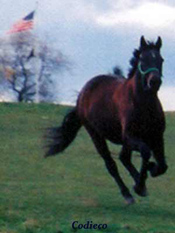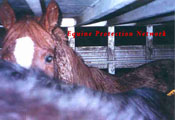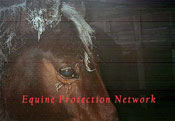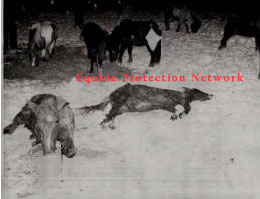
Shop for CD's at CDRush.com & the EPN Benefits!
Put "EPN" in the Coupon Code box when you place your order.
Now you can save money on your favorite music and help the horses at the same time!
EPN Website Sections
Press Stories 1980-2004
The Final Roundup Pittsburgh Magazine 5 /2004
Fighting to Stop the Sale & Slaughter of US Horses in Foreign Countries - KDKA TV Investigates 4/30/2004
The Slaughter Question Horse & Rider 12/2002
State Ranks High in Equine Slaughter WTAE's Paul Van Osdol Reports 4/27/2001
Slaughterhouse Ride WISH TV News 8 I-Team Investigative Report 4/2001
Illinois Defeats Horse Slaughterhouse! 1999
Kill Sale Pittsburgh Post Gazette 6/ 1999
Horses To Slaughter
Police, vet check horses' health at New Holland sale
July 1998
PA Horse Transport Legislation - Act 64 of 2001
Horse Transport Bill Passes Unanimously WTAE's Paul Van Osdol Reports 6/21/2001
State Lawmakers Urged to Protect Horses en route to Slaughterhouses
June 1998
State Concerned with Cruelty to Horses Taken for Slaughter
'TRAIL OF TORTURE' ?
June 1998
Horse-Slaughter Industry Critics Pushing Changes
PA. Bill Would Help Protect Horses Headed to Slaughter
March 28, 1998
The goal is a humane trip for horses on the way to be killed for their meat, prized in Europe.
New York Does PA's Dirty Work January 1998
NYSP Stop Double Deck Trailer

Horses inside double deck cattle trailer stopped by the NYSP. The owner was later convicted & fined $3000.00.
Horse Popsicle Case 1994
Cruel Transport Results in $11,100 Fine

Horses inside double decker covered with frost.
The Last Ride
Eyewitness Account of trip to Slaughterhouse
Overcrowding, negligence plague Shelby horse feedlot
Great Falls Tribune 8/10/2003
The Torture Trail
December 1980
85 horses in trailer, 57 survive

A dead horse lies in the snow, while another too weak to rise eats from a bucket.
The Miracle Mile July 1990
Pregnant Mare Foals Hours After Rescue From Slaughterhouse-
Foal is a Stakes Winner
!
Pasturemate of the Stakes Winner, "On Route 66" who was born only hours after her dam was taken from a slaughterhouse
PA Dealer Sent to Prison 1999
Shady Horse Dealing
Renaissance Bob 12/ 1998
Rescue of a Racehorse
An Eye For An Eye
Story of Catch-22

Links
California Voters "Just Say Neigh" to Horse Slaughter!
HoofPAC
Shop online at IGive.com with over 600 great stores you know & love- including Back In the Saddle! Up to 26% of the purchase price is donated to the EPN!
The EPN gets $5 extra the first time you shop!
PayPal accepts credit cards! Please send your tax deductible donation to the:Equine Protection Network, Inc.,
P. O. Box 232, Friedensburg, PA, 17933.
HoofPAC is the political action committee that has been formed to end the slaughter of America's horses. Cathleen Doyle, founder of HoofPAC, led the successful Save The Horses campaign in 1998 that made the slaughter of California's horses a felony.
Contact the EPN
Did You Know?
"You do the same thing we do with unwanted dogs and cats in this country. If you can afford to own a horse, you can afford to put one down at the end of its days. We'd love for every horse to live in a bucolic pasture until it's 30. That's never going to happen. The reality is that this animal served you and served you hard. He deserves a painless death rather than having a nail slammed in his head, sometimes three or four times until they get it right."
Cathleen Doyle - HoofPAC
Page last revised on:

Click to help raise funds for mammograms for women.
Note: Since this story was published 1 American horse slaughterhouses has closed, Central Nebraska Packing in North Platte, NE.
Prop 6 in CA made the sale of CA horses to slaughter a felony, not a misdemeanor as reported in this article.

This is the first of a two-part investigation into the inhumane slaughter of horses.
DEAD END
By Bill Finley, Daily News Sports Writer
Rescue of a Racehorse
They threw a beloved hero named Secretariat a farewell party, attended by 32,990 people on a crisp autumn afternoon in 1973 at Aqueduct, before sending him off to his Graceland, also known as Claiborne Farm.
The pomp and circumstance included a letter from the governor of New York, Nelson Rockefeller.
For thousands of other thoroughbreds just off the track, those not gifted enough or lucky enough to spend the rest of their natural lives pampered in the splendor of a Kentucky breeding farm, the long goodbye comes in the form of repeated bludgeoning in the skull by a deadbolt gun with a four-inch nail.
That was the beginning of the end last year for an estimated 7,700 thoroughbreds or about one out of every nine horses who raced who were killed in four U.S. slaughterhouses that handle horses for human consumption. The nail stuns them. Then they are shackled, hoisted in the air and their throats are slit before being dismembered and eventually served for dinner in Europe, Asia or Mexico.
It may be a repulsive scenario, but it is also a reality for an industrythat hasn't figured out what to do with the thousands of slow and infirm horses who leave the track every year, worth no more than the value of the meat on their bones.
What is the answer? It is difficult to even figure out what the question is.
Are horses companion animals, deserving of love and care? Are they like dogs and cats, animals most Americans would never slaughter for human consumption? Or are they commodities, no different than slaughter-bound cows and pigs? If some are treated like heroes, why should others be discarded like yesterday's garbage?
"It is humans that brought these horses into the world and we control their every move and their health. They are utterly dependent upon us,"
said Penny Chenery, Secretariat's owner and a member of the board of the Thoroughbred Retirement Foundation.
"We as humans have an obligation to see that there is a viable alternative for them after they no longer suit the purposes we brought them here for. You have a responsibility to see that a horse's life has a proper outcome."
That, however, is not always as easy as Chenery might make it sound.
"If a horse is no longer useable and has no potential, what else are people supposed to do with it?"
said Arlow Kiehl, who buys horses from auctions before selling them off at a small profit to a slaughterhouse.
"I can't afford to let them run around and just look at them. Where else are they going to go but to slaughter? There are some real tender-hearted people out there and you can't explain this to them. There are some real fruitcakes running around who can't listen to reason."
Around the race track, they call people in Kiehl's business"killers." Once a horse falls into their hands, it's usually over. Kiehl says that he evaluates every horse that makes its way to his Watertown, N.Y. farm. Those which are healthy and useful will be resold, he says, perhaps to riding stables. But most, he admits, wind up being slaughtered.
It is another Monday at the New Holland Sales Stable in Pennsylvania Dutch country and Kiehl is one of about a half dozen "killers" in attendance on this late-November afternoon to buy horses for resale to the slaughterhouses. Horses are sold every Monday at New Holland, one of a handful of rag-tag sales that bear no resemblance to the prestigious events at Keeneland and Saratoga, where future racing prospects can go for millions. Most of the horses aren't even thoroughbreds. They are standardbreds, cross-breds, draft horses. Horsemeat is horsemeat.
Oddly, about the only thing that can save a horse who has fallen this far is its color. The horsemeat industry shies away from grays."Caution must be exercised when buying gray horses or variations of gray horses," reads a notice sent out to horse sellers by Beltex, a Fort Worth, Tex., slaughterhouse.
"All gray horses are inspectedby the USDA for indications of melanoma . . . .Gray horses very often do not pass USDA inspection."
While they may have started out their careers on the country's more prestigious racing circuits, horses who end up at New Holland usually finished their careers at nearby tracks Penn National, Charles Town and Finger Lakes. Middlemen operate at each of those tracks, knowing that there are plenty of owners and trainers eager to rid their barns of horses who can no longer cut it. A soft heart is not a job requirement.
"I just sell horses," said Charles DeHart, who was dealing on this day at New Holland. "Where they go from here is other people's business."
No one cares who the horses are or what they did on the track.All that matters now is their weight. Beltex is currently paying 51 cents a pound for a healthy, good-sized thoroughbred, most of whom weigh about 1,100 pounds. That makes an average horse worth about $561 by the time they reach the end.
Along the way, the middleman and the "killer" each take a small cut over and above the price for which a trainer sells a horse off the track. Kiehl says he expects to make only $40 per horse on the ones purchased at New Holland.
Next is the trip to the slaughterhouse, which, more than any other part of the journey from the winner's circle to the dinner table, has drawn the wrath of animal rights activists. The horses are crammed into trucks, some geared to haul smaller animals such as cows, and herefore too low to allow them to stand properly. They're sometimes driven as far as 1,000 miles with no rest or feed and water breaks, none of which are required by federal regulations.
Some of the horses, lame and infirm, are in no shape to handle such rough travel but they cannot be put down beforehand because the toxins used to euthanize a horse make it unfit for consumption "Fights break out and injuries are frequent," said Jackie McTigue, program spcialist, equine protection division of the Humane Society of the U.S.
"Sometimes the horse doesn't even survive the journey."
No official records are kept regarding what percentage of horses slaughtered are thoroughbreds, but the Humane Society of theUnited States estimates the figure to be 10 percent. According to the Food Safety and Inspection Service, 77,000 horses were slaughtered in the U.S. in 1997. That's down from an all-time of 315,000 in 1990, when more than 20 equine slaughterhouses operated in this country and an estimated 31,000 thoroughbreds were killed.
Not that horse lovers are necessarily winning. "One of the reasons it is down is because the dollar is so strong," said Geert DeWulf, general plant manager of Kaufman, Texas slaughterhouse Dallas Crown Inc.
"All of our product is going to overseas markets and a strong dollar does not help anyone export American products. The other reason is that there is now more production of horsemeat in other parts of the world."
Dallas Crown, Beltex, Cavel International and Central Nebraska Packing are all that are left. Another, Cavel West in Redmond, Oregon was closed after being bombed July 21, 1997 by a radical animal rights group, the Animal Liberation Front.
Americans may find the thought of eating Black Beauty, Trigger or the $36.40 winner they had las summer at Saratoga repulsive. But some diners in France, Belgium, Switzerland, the Netherlands, Italy, Germany and Japan have no such qualms. "Retail cuts of horse are similar to those of beef," a Feb. 1997 USDA advisory reads.
"The meat is leaner, slightly sweeter in taste, with a flavor somewhat between that of beef and venison."
And so it happens, and not only to the horse who was just beaten 40 lengths in a $3,000 claimer at Finger Lakes. Racing writer Mike Mullaney uncovered that Exceller, a Grade I winner in both the U.S. and Europe and the only horse ever to beat two Triple Crown winners, ended up in a slaughterhouse in Sweden last year.
"Exceller knew what was going on; he didn't want to be there,"Ann Pagmar, who cared for Exceller for owner Gote Ostlund, told Mullaney, after taking him to the slaughterhouse as per the owner's orders. "Standing with him like that, it made me feel like Judas."
Exceller's demise sent shock waves through the industry and helped raised awareness of the problem, but only marginal progress has been made since his death. It's still a matter of economics. It would take untold millions and thousands of acres of land to take care of each and every unwanted ex-racehorse who comes off the track. The small-time owners, the ones that wind up with the cheap horses at the ends of their careers, say they can't afford it. The ones who can, the wealthy owners and breeders who race for big money with valuable horses, often say it's not their problem. Some racetracks contribute, but the amount of money donated to the various thoroughbred rescue groups, all of whom operate on shoestring budgets, amounts to a fraction of what is bet on a single race at Belmont Park.
"I don't think this industry does enough,"
said Philadelphia Park CEO Hal Handel, among the more generous contributors to the Thoroughbred Retirement Foundation.
"This is an important issue and we have to start doing the right thing. I'm not just talking about racetracks, but owners and breeders. Everyone who is involved in this industry has an obligation to the animal. We sell to the public the beauty of the horses and the love that we have for them and how that's a critical element of this sport. We then can't let this happen to these horses."
Cathleen Doyle got tired of hearing the same tired excuses. Teaming up with friends Sherry DeBoer and Sidne Long, Doyle got the first-ever statewide initiative banning the sale of horses for slaughter onto the California ballot this year. It passed overwhelmingly and it is now a felony in California to possess, import or export a horse for the purposes of human consumption. Selling horsemeat is a misdemeanor.
"The people of this state spoke up they don't want horses slaughtered for human consumption," she said.
But Doyle is the first to admit that the new California laws cannot possibly save all of the state's unwanted horses
"What do you do with those horses? It's a no-brainer," she said.
"You do the same thing we do with unwanted dogs and cats in this country. If you can afford to own a horse, you can afford to put one down at the end of its days. We'd love for every horse to live in a bucolic pasture until it's 30. That's never going to happen. The reality is that this animal served you and served you hard. He deserves a painless death rather than having a nail slammed in his head, sometimes three or four times until they get it right."
Doyle, and her group, Save the Horses, is part of a growing effort to at least put a dent into the problem. The Thoroughbred Retirement Foundation is the oldest and best-known of the country's myriad thoroughbred rescue organizations.
"People need to realize that this is a very workable problem; it just takes more money than we have," said the TRF's Pikulski. "What we do can do nothing but good things for racing and its image with the public."
But with its current level of funding, the TRF can afford to care for only 200 horses. Obviously the industry could do more, but doing so might raise awareness that this underpublicized and controversial problem exists.
So it often chooses a strategy of benign neglect. It celebrates the pageantry, the "go, baby, go" excitement and the millions paid out in purse money, but then can't come up with a way to care for many of the animals who make it all possible. At least not for the ones who did one simple thing wrong: they didn't run fast enough to serve mankind's purposes. For that, they get a nail slammed into the skull.
Original Publication Date: 12/20/1998
Monday, December 21, 1998
Racehorse saved from slaughter This is the second of a two-part investigation into the inhumane slaughter of horses.
His name is Renaissance Bob, and he prefers carrots to apples. He was named after a former owner, Bob Greenhut, who produced the film "Renaissance Man."
Renaissance Bob liked the mud, and he won an allowance race once at Saratoga, one of 10 wins in his career. He's as gentle and sweet as a 6-week-old puppy. That is who he is.
No one at the Nov. 23 horse sales in New Holland, Pa., knew any of that as Hip No. 642 was led into the ring and kept there by an Amish man with a bull whip and an attitude. They didn't know his name, and they didn't care.
I'd come to New Holland in search of a story: I would buy a slaughter-bound horse, saving it from an early exit, then research the animal's life. There was nothing particularly humanitarian about my motives. I eat meat and would tell any vegetarian that it's my right to do so. Save the whales? Whatever.
Renaissance Bob had been cheered by thousands that day at Saratoga, a distant and meaningless memory as potential buyers considered only his weight: about 1,060 pounds.
That's all that mattered to Arlow Kiehl, one of about a half-dozen "killers" among the crowd of some 150 at the New Holland Sales.
Kiehl may not have known who Bob was, but he knew what he was: an infirm horse about to take his last lap. Lame in his left front leg and unable to race over the previous two years, the 7-year-old chestnut gelding had no value as a racehorse and had been so beaten down by racing that he was of no use as a riding horse.
Kiehl bought him at auction for $500, knowing that a slaughterhouse would pay him a few dollars more for Bob, then ship his flesh off to Europe or maybe Asia or Mexico, where consumers would see him as a main course. According to the Food Safety and Inspection Service, a division of the Agriculture Department, 77,000 horses were slaughtered in the U.S. in 1997, 10% of which were thoroughbreds.
Kiehl would take Bob to his Watertown, N.Y., farm, inspect him, and then ship him to the Barton Feeder slaughterhouse in Owen Sound, Ontario.
Kiehl would get about $540, while Bob would be rendered unconscious by a stun gun that would deliver a four-inch nail into his head. He would then be shackled, hoisted into the air and finished off by having his throat cut. From there, he would be dismembered and carved into steaks.
How does a horse go from a beloved and pampered athlete to yesterday's leftovers? From the winner'scircle at Saratoga to the Barton Feeder Slaughterhouse? The trip is a lot shorter than you would think.
Renaissance Bob was born May 26, 1991, at Highcliff Farm in Delanson, N.Y., a son of Cannon Shell out of the mare Miss Natchez. That's the exciting time, when they could still turn out to be anything. Lil E. Tee, the winner of the next year's Kentucky Derby, was every bit as modestly bred.
Breeder Seymour Cohn decided to sell Bob, who went for $2,700 at a Florida yearling sale. A year later, the price was up to $18,000, what Greenhut and trainer John DeStefano paid for him at a Saratoga 2-year-old sale.
Bob was already exhibiting the characteristics that would mark his life and career a gentle nature, an intense will to win and striking good looks.
"He was a beautiful horse," DeStefano remembered.
And he could run a little bit.
Bob's career began in a $35,000 maiden claimer at Aqueduct on April 5, 1994. With John Velazquez aboard, Bob struggled, finishing eighth, but three starts later he would hit his stride. Bob broke his maiden May 27, 1994, winning a New York-bred maiden special at Belmont by six lengths under Mike Luzzi. Three starts later, he was standing in the winner's circle at the most prestigious race track in the country, Saratoga, having won by 5½ lengths under Robbie Davis.
For that one brief moment, Bob embodied the image racing wants you to know about. Saratoga is a wonderful place and there were a lot of people there that day. They gave DeStefano a trophy, and 11 people crowded into the winner's circle picture, proud to be standing next to Bob. After the race, he was taken back to a comfortable stall in the DeStefano barn, where he no doubt got the best food and care available from a conscientious horseman.
After that came the depressing though typical fall from grace. There are always stops along the way for horses on the downside, cheaper tracks and new barns. In Bob's case, things were never the same.
He lost his next four starts, including a $17,500 claimer, and DeStefano knew the horse could no longer cut it in New York. He sold him to a friend, Chris Potash, who sent him to the next level down, the Maryland circuit. Bob managed to win a $6,250 claimer at Laurel, but after a fifth-place finish in an $8,500 claimer there, he was forced to go a step lower. Potash shipped him to Penn National, where he was claimed for $6,250 by trainer Ken Smith.
"He was my pet," Potash said. "Without a doubt, my favorite horse I ever owned. He was that lovable."
Under Smith, Bob wound up at Finger Lakes, where he raced 14 times, winning four more cheap races. Smith sent him back to Penn National and Potash claimed his pet back. Bob stuck around, winning three more bottom-level claimers. He was claimed again, Aug. 9, 1996, and Potash took him right back in his next start. Potash and his trainer, Harry Thompson, lost him again, this time to Rick Wasserman, who got Bob to run third in a $5,000 claimer on Dec. 13, 1996, at Penn National. Bob, who had earned $86,925 for his owners, would never run again.
With Wasserman, Bob's growing list of physical problems, which included joint deterioration in his left front leg, became more than his owner could handle. Wasserman decided to cut his losses, selling Bob for $1,500 to trainer Gina Kreiser, who had hoped to nurse him back to the races.
"He never got sound for me," Kreiser said. "He'd get a little bit sound then get lame again. I never even trained him."
At $300 a month, Bob stayed under Kreiser's care at a farm near Penn National for nearly two years. Finally, Kreiser grew unwilling to foot any more bills, fully aware that decision meant Bob would likely be killed. Economics over sentiment.
"A lot of people would have sent him to the 'killers' a lot sooner than I did," Kreiser said. "Rick Wasserman kept saying to me, 'Why don't you get rid of that horse?' A couple of people were interested in him as a riding horse, but it didn't work out. Sure, I felt bad about this, but it comes down to whether or not a horse can pay for himself, and if he can't, he has no use to a lot of people. I needed him gone."
Kreiser sold Bob for $340 to Charles DeHart, who scours the cheaper Mid-Atlantic tracks for horses he can resell to "killers" such as Kiehl at places like New Holland. In Kiehl's hands, Bob was destined to die in a slaughterhouse, at least until a newspaper needed an unusual subject for a profile.
With the assistance of jockey Julie Krone, I bought Bob for $550 out of the "killer pen," where the chestnut and 38 other horses awaited what would be their last ride. Kiehl said that as long as the horse was infirm (he was), he would be sent to a Canadian slaughterhouse within a few days.
I had no idea who he was until the next day, when the Jockey Club matched up his lip tattoo number with an identity. I got my story. He got a good home.
Few things I have done have made me feel better than saving Bob. I've gotten to know this horse a little bit, and I can tell you he's a living, breathing sweetheart of an animal, not a commodity, and he deserves a lot better than what mankind had in store.
After my purchase, Bob was shipped to the farm of standardbred trainers Phil Klein and Sandy Pikulski in Clarksburg, N.J. He has been donated to the Thoroughbred Retirement Foundation, run by Pikulski's sister, Diana. Placement in the TRF program guarantees that Bob will live out his life well taken care of.
Honestly, it doesn't appear that he's capable of anything other than relaxing in his paddock, eating his carrots and apples while Nat King Cole and Tony Bennett and Frank Sinatra waft through the barn. Bob has put on some much-needed weight and he's not as skittish as he was when he arrived. I think he's pretty happy.
Yanni's Sad End
By BILL FINLEY
Daily News Sports Writer
An estimated 7,700 former racehorses will be sent to slaughterhouses in the U.S. this year, and several more will meet similar deaths in Canada. No one knows who they are, and many former owners never know what happens to them.
But each horse has a name and a story, like that of Yanni's Winner. She was slaughtered some time after being sold Nov. 23 at New Holland.
Poorly bred, never worth more than a few thousand dollars, the daughter of Commadore C. didn't show much in a 31-start career. After the horse finished 10th in a $5,000 claiming race at Philadelphia Park on Nov. 2, Stanley Sager, who trained the mare for his wife, Nancy, was told that he was losing the stall space allotted to her. Sager said he tried to find a home for Yanni's Winner but found no takers.
"Sure, it makes you feel bad, but what else are you going to do?"Sager said.
Instead, he sold her for $300 to Peter Zanette, a small-time trainer who buys horses at the Pennsylvania tracks and resells them at sales such as New Holland. A small filly whose weight reduced her value as horse meat, Yanni's Winner fetched only $360 at New Holland, going to "killer" Donald Nickerson. Following the Nov. 23 sale, Nickerson shipped Yanni's Winner to a Texas slaughterhouse, where she was killed, less than a month after her last race. She won twice in her career, earning only $14,893.
"Does it bother me? Why would it?" Zanette said. "Does it bother you to eat a steak? The slaughter of an animal is a hideous event, but you can't humanize an animal. Slaughter is something that has to be done."
Bred by Astoria resident Ioannis (Yanni) Dinos, Yanni's Winner raced throughout much of her career for trainer George Angelopos, who sold her over the summer to Sager for $1,500. Angelopos was shocked and furious when informed that Sager sent Yanni's Winner to her death.
"That rat," Angelopos said. "When I sold her to him he said he'd have a nice home for her if things didn't work out. That's the only reason I sold her to him. I have a full sister to her that is getting ready to run and has a lot of ability. (Yanni's Winner) would have been worth something as a broodmare. I didn't believe in the slaughter of horses. If that guy needed $300 so bad he ought to get out of the game."
